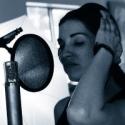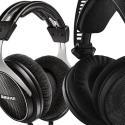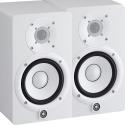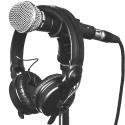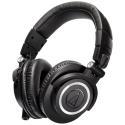What is HiFi: The Ultimate Guide to High-Fidelity Audio
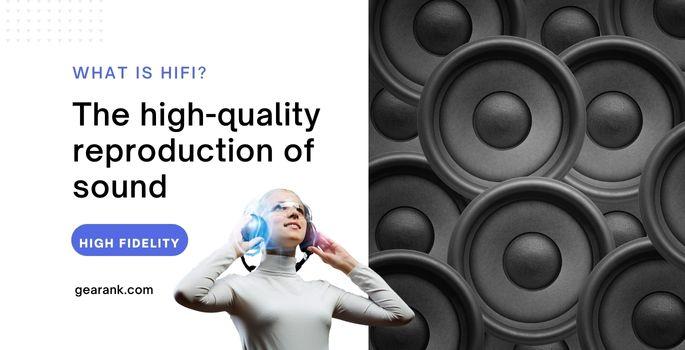
You've probably heard the term "hi-fi," used to reference music at some point. But what is HiFi all about?
Audiophiles are careful when using "hi fi" or high fidelity. And these words usually refer to the precise sound reproduction offered by expensive stereos and other devices.
It is a label describing equipment or high-quality audio recordings for everyone else.
In this article, I'll discuss hi-fi, so you can understand why it remains the gold standard for audio quality.
About Hifi
Hi-fi audio is short for high fidelity audio. "Fidelity" here means quality. It feels like the music you listen to is being played right before you.
This can only be achieved with highly detailed sound reproduction and low distortion levels. The original sound has to be heard as clearly as possible.
High fidelity audio is clear, clean, sharp, and free of distortion and other unpleasant artifacts sonically.
On the flip side, some people appreciate lo fi audio. Lo-fi audio sounds old, broken, and fuzzy - but in a good way.
What Is Hi Fi Audio Equipment?
Any equipment used to play high-quality audio is referred to as hi-fi equipment. This consists of earbuds, speakers, sound bars, amplifiers, sound cards and more.
A Hi Fi sound system creates sound with incredible attention to detail. You're no longer just listening, you are sensing and feeling the instruments playing in the music.
Hi-Fi audio equipment accomplishes this by removing extra noise and distortion. The result is a superb and immersive listening experience. These equipment are perfect for enjoying high definition movies and audio formats.
Timeline Of Hi-Fi
The following is how hi fi has changed over the years and what it is today.
Origins
The phrase "hi-fi" or "high fidelity" first appeared in the 1950s. They refer to audio equipment that could accurately recreate music. It indicated that the music had the same immersive quality as hearing the band or artist live.
The meaning of "high-fidelity" has changed as audio technology and our listening habits changed.
1970s
With the arrival of stereo sound in the 1970s, the concept of hi-fi changed. A second channel or speaker allowed stereo to give the music an additional depth of spatial realism.
1980s
When CDs first appeared in the early 1980s, they significantly reduced the amount of excess noise. This includes the crackling and other flaws that vinyl records are now prized for.
CDs were among the first widely used digital formats of audio. This paved the path for the current era of on-demand digital music streaming.
Present Day
The popularity of compressed digital audio files, such as MP3, during the 1990s caused quality to take a detour. This is because MP3 compresses audio data to reduce the file size. And they are usually played through inexpensive audio equipment.
Listen to digital audio files with the same or more excellent audio quality as a CD. Some major music streaming platforms provide an uncompressed streaming tier. This includes Amazon, Tidal, Deezer, and Qobuz.
The challenge in today's world is that many different mediums are in use. This includes CDs, streaming, tapes, and even vinyl (which has a big following) - and they all have varying degrees of fidelity.
In 2014, the Consumer Electronics Association, The Recording Academy, and the Digital Entertainment Group came together to define hi-fi audio. They describe it as lossless audio, which can reproduce all the sonic details of recordings that were mastering music using better than CD-quality sources.
Hifi Is Higher Quality Than CD
Hi-fi was once considered audio of CD or vinyl resolution (16-bit/44.1 kHz). However, today you may listen to file formats with greater resolutions (such as 24-bit/192 kHz or 32-bit/384 kHz). These high resolution audio formats with higher sample rates are considered hi-fi quality.
Sample rate and bit depth have to do with the digital-to-analog conversion process.
A digital-to-analog converter, or DAC, samples the digital audio information that an audio source outputs. It sends the output to transform the audio from its digital form and create an analog waveform.
The sample rate is the rate at which the DAC acquires these samples. The sampling rate of a CD is 44.1 kHz since 44,100 samples are taken every second.
The number of amplitude values you can record for each audio sample depends on the bit depth. The most popular bit depths are 16, 24, and 32 bits.
We consider audio high-end (hi-fi) if the file carries the whole frequency range. There should be no loss of information due to compression.
In terms of what constitutes hi-fi audio, there is no set standard. Anything superior to CD quality is termed hi-fi. Sample rates for hi-fi audio typically range between 96 kHz to 192 kHz at 24-bit depth and can be higher in rare circumstances.
Is There A Difference Between High Fidelity And High Definition?
High Fidelity Audio is a well-established term that focuses on accurate sound reproduction. As mentioned above, it is about getting all the frequencies to the listener, hence the term lossless audio. And it can apply to both digital and analog audio - depending on the equipment used.
High Definition is commonly used in photos, videos, and related devices. But when it comes to High Definition Audio, there is no agreed-upon definition. It is usually used as a marketing term to relate sound quality to how we perceive video quality. It could mean high resolution audio files or surround sound. But with no established standard, the term can be misleading. This may change in the future when this qualitative term becomes standardized.
Both are descriptors of high-quality audio, but as of this writing, Hi-Fi is the more reliable term.
High Fidelity Is For Everyone
Everyone can appreciate Hi-Fi sound, not just audiophiles. Everyone who likes music and wants to listen to it most genuinely can benefit from high-quality audio.
Listening to your favorite albums through a hi-fi audio system will give you a more immersive experience. The added depth and spatial clarity make the music you are listening to sound alive.
If you enjoy listening to jazz or classical music, the first time you hear it on a hi-fi system can be a life-changing experience. You will understand the sensation of "being there." You can listen to a trumpet player's gentle breath as their sorrowful solo begins. You can better appreciate a classical choir's rich and clear voices. And you can immerse yourself in the alluring atmosphere of an orchestra performing Beethoven.
This is why manufacturers of everyday gadgets like Apple have developed their lossless audio technology. So that more people can enjoy high-quality music and sound through earphones or their sound systems.
There is no turning back when you discover this new method of experiencing music. You no longer listen to sound; you feel it.
Today's Hi-Fi audio experience results from years of research and constant development. We can now fully take in music in a more life-like way. This is thanks to the perfection-seeking efforts of musicians, audio engineers, and cutting-edge sound labs.
Listening To Hi Fi Audio Files
Hi-Fi requires a sound system that can reproduce all the sonic details of a recording. And for that, you'll need to upgrade your listening equipment. The typical computer sound card must be more high-quality to output hi-fi audio.
First, a digital-to-analog converter (DAC)is required. A DAC will convert the digital audio data from the audio source to analog while enhancing the signal slightly.
Some DACs come with built-in amplifiers. Getting an all-in-one DAC may be a good idea if you're on a tight budget or a beginning audiophile. I suggest getting a standalone DAC if you can.
Compared to all-in-one devices, standalone DACs, and amps offer higher specifications. They have greater power and generally superior responsiveness. You then need to purchase an external amplifier.
Different Types Of High Fidelity Files
You might already be aware of numerous audio file types, such as MP3, AAC, or WAV.
Some audio file types (particularly AAC and MP3) are lossy. This means that through the encoding process, quality is lost, and they stray from the intended studio sound.
If you wish to listen to high fidelity audio with few issues, then you ought to look for the following file types:
- WAV - Short for Waveform Audio File Format. Wav files are uncompressed, so they have enormous file sizes and consume a lot of storage space. WAV audio files have excellent sound quality despite their large file size.
- FLAC - This acronym stands for Free Lossless Audio Compression. The files are half the size of WAV files. Although, FLAC is incompatible with Apple devices.
- AIFF - Audio Interchange File Format is the WAV equivalent for Apple users. This file format is similar to WAV files. They are uncompressed and use a large amount of file storage space. But the plus side is better high resolution audio quality.
- ALAC - Apple Lossless Audio Codec takes up much less space when compared to WAV formats. It will work on iOS devices, and you can also get the files to work on iTunes.
- MQA - This lossy audio format is even more compact and has higher quality than FLAC. The MQA file format is used by Tidal Masters hi-fi streaming, which is still relatively unheard of but gaining popularity.
Invest in an external storage disk to free up space on your computer. Otherwise, think about uploading the hi-fi audio files you've purchased to the cloud.
Advantages And Disadvantages Of Hi-fi
Even though hi-fi is considered excellent regarding the quality of songs, it produces. This type of sound quality could be better, with advantages and disadvantages.
Advantages
Audio Quality - The main advantage of hi-fi audio is that it produces crisper and clearer sounds. You can hear every tiny detail in these files.
Accurate Reproduction - Compared to lower-resolution sound files, they exhibit a high degree of accuracy in reproducing the original characteristics of the recorded audio.
More Enjoyable Experience - Due to the accuracy of the audio, listeners can have a much more enjoyable listening experience every time.
Disadvantages
Limited Availability - Your selections are constrained to hi-fi services like Tidal. Primary music streaming services like Apple Music and Spotify do not specialize in this format.
Special software Required - You must use specialized media players to maximize hi-fi audio. This software can play audio at greater bit depths and sample rates.
Takes Up Lots Of Space - This is the main downside of Hi-fi music; sound files are enormous. They can take up lots of space on your device or computer.
Frequently Asked Questions
Why Is Hi Fi So Expensive?
Hi fi is expensive because specialist equipment and software are needed to reproduce the most transparent and best sounds possible. These high-end components involve more significant spending. And hi-fi sound files take up a lot of space, which means more cost to stream or save on to your device. But if you want nothing less than high quality music, then Hi-Fi is worth saving up to.
Why Does Hi-Fi Sound Better At Night?
It is known that all music, including hi fi, sounds better at night. This is because there are fewer ambient sounds, which can distract you. Hence, since background noise is at a minimum, this makes your music and audio sound better.
Is Hi Fi Audio Noticeable?
If you are listening to hi fi audio, you will be able to notice a difference straight away. There is a huge difference since there is a higher bit depth and sample rate. Thus, you can hear every little detail and sound in your audio track. You can immerse yourself in the audio a lot easier than before.
Conclusion
If you want to listen to the highest quality sound or music, Hi-Fi is for you. Listening to hi-fi audio through high fidelity equipment is a life-changing experience.
The more significant sample rate and bit depths allow these sound files to reveal all the details captured during recording. At the same time, hi-fi audio equipment lets you hear every detail for a truly immersive listening experience.
If you found this What is hifi? article interesting, you may want to also read What is EQ in Music? and The Helmut Haas Effect from 1949.



